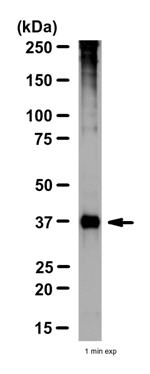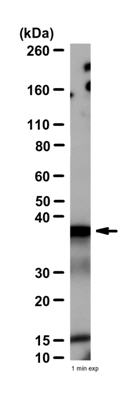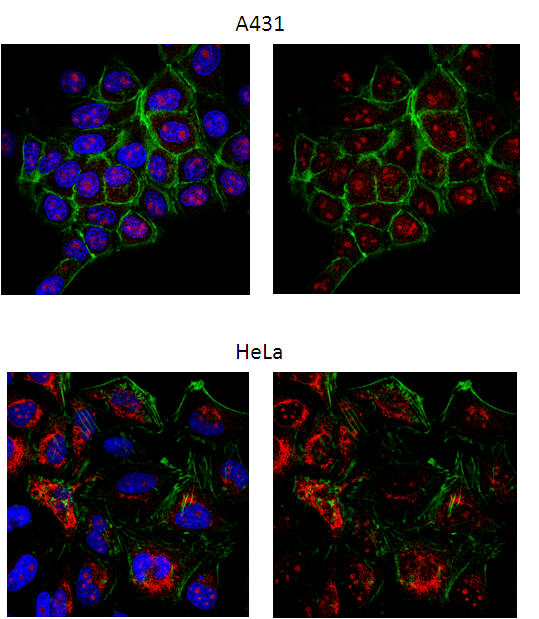PC130 Sigma-AldrichAnti-Rad51 (Ab-1) Rabbit pAb
This Anti-Rad51 (Ab-1) Rabbit pAb is validated for use in Immunoblotting, Immunoprecipitation, Immunocytochemistry for the detection of Rad51 (Ab-1).
More>> This Anti-Rad51 (Ab-1) Rabbit pAb is validated for use in Immunoblotting, Immunoprecipitation, Immunocytochemistry for the detection of Rad51 (Ab-1). Less<<Recommended Products
概述
| Replacement Information |
|---|
重要规格表
| Species Reactivity | Host | Antibody Type |
|---|---|---|
| H, M, R | Rb | Polyclonal Antibody |
价格及供货情况
| 产品目录编号 | 库存情况 | 包装 | 数量 / 包装 | 价格 | 数量 | |
|---|---|---|---|---|---|---|
| PC130-100ULCN |
|
塑胶安瓿;塑胶针药瓶 | 100 ul |
|
— |
| Product Information | |
|---|---|
| Form | Liquid |
| Formulation | In 150 mM NaCl, 100 mM Tris-Glycine, pH 7.4 |
| Positive control | A431 cells, HeLa cells |
| Preservative | ≤0.1% sodium azide |
| Quality Level | MQ100 |
| Biological Information | |
|---|---|
| Immunogen | recombinant, human Rad51 |
| Immunogen | Human |
| Host | Rabbit |
| Isotype | IgG |
| Species Reactivity |
|
| Antibody Type | Polyclonal Antibody |
| Physicochemical Information |
|---|
| Dimensions |
|---|
| Materials Information |
|---|
| Toxicological Information |
|---|
| Safety Information according to GHS |
|---|
| Safety Information |
|---|
| Product Usage Statements |
|---|
| Packaging Information |
|---|
| Transport Information |
|---|
| Supplemental Information |
|---|
| Specifications |
|---|
| Global Trade Item Number | |
|---|---|
| 产品目录编号 | GTIN |
| PC130-100ULCN | 07790788053949 |
Documentation
Anti-Rad51 (Ab-1) Rabbit pAb 分析证书
| 标题 | 批号 |
|---|---|
| PC130 |
参考
| 参考信息概述 |
|---|
| Brendel, V., et al. 1997. J. Mol. Evol. 44, 528. Boulikas, T., et al. 1997. Anticancer Res. 17, 843. Gupta, R.C., et al. 1997. Proc. Natl. Acad. Sci. USA 94, 463. Mizuta, R., et al. 1997. Proc. Natl. Acad. Sci. USA 94, 6927. Sharan, S.K., et al. 1997. Nature 386, 304. Li, M.J., et al. 1996. Proc. Natl. Acad. Sci. USA 93, 10222. Shen, Z., et al. 1996. J. Biol. Chem. 271, 148. Sturzbecher, H.W., et al. 1996. EMBO J. 15, 1992. Tashiro, S., et al. 1996. Oncogene 12, 2165. Ashley, T., et al. 1995. Chromosoma 104, 19. Haaf, T., et al. 1995. Proc. Natl. Acad. Sci. USA 92, 2298. |
引用
| 标题 | |
|---|---|
|
| 数据表 | ||||||||||||||||||||||||||||||||||||||||||
|---|---|---|---|---|---|---|---|---|---|---|---|---|---|---|---|---|---|---|---|---|---|---|---|---|---|---|---|---|---|---|---|---|---|---|---|---|---|---|---|---|---|---|
|
Note that this data sheet is not lot-specific and is representative of the current specifications for this product. Please consult the vial label and the certificate of analysis for information on specific lots. Also note that shipping conditions may differ from storage conditions.
|
















